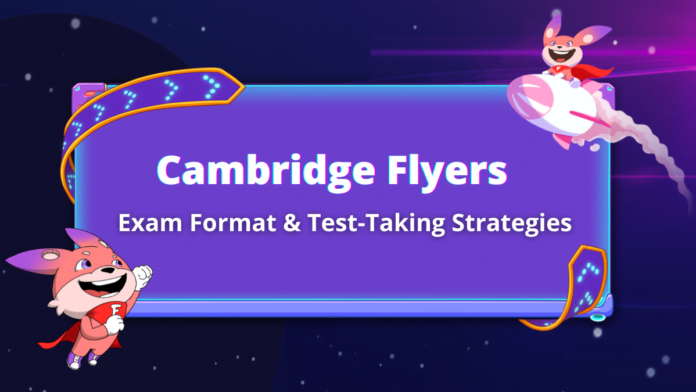A2 Flyers is the highest level in the Young Learners English (YLE) certification series, organized and awarded by the University of Cambridge’s English Language Assessment Council. This certificate evaluates children’s proficiency in the language through three exams: Listening, Reading & Writing and Speaking. What are the Cambridge Flyers exam format and the test-taking strategies? Check it out in this article and don’t forget to give children these advice before their exam day!
1. Cambridge Flyers exam’s latest format
The Cambridge Flyers exam consists of three sections with a total exam time of approximately 1 hour and 14 minutes, as follows:
| Test | Duration | Questions |
|---|---|---|
| Listening | 25 minutes | 5 parts/ 25 questions |
| Reading & Writing | 40 minutes | 7 parts/ 44 questions |
| Speaking | 7-9 minutes | 4 parts |
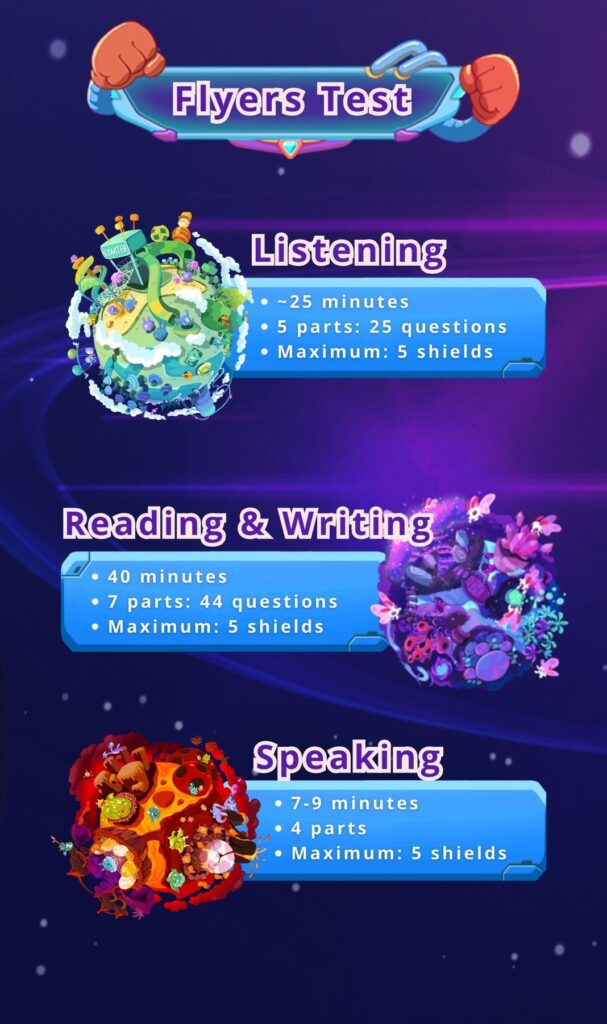
1.1. Listening test
| Duration | 25 minutes |
| Number of sections | 5 parts/ 25 questions |
| Maximum Score | 5 shields |
Detailed Structure of the Flyers Listening Test:
| Test Section | Instructions | Necessary skills |
|---|---|---|
| Part 1 | Candidates will see a picture showing characters engaged in activities. Candidates must listen to a conversation and match the given names with the correct person in the picture. | Listening to names and descriptions of characters. |
| Part 2 | Candidates listen to a conversation and fill in the blank with one word or one number. | Listening to names, spelling, and selecting specific information. |
| Part 3 | Students view two sets of pictures: one set with characters/locations/objects and another with images labeled with letters. They listen to the conversation and fill in the blanks with letters to match the corresponding pictures from both sets. | Listening to words, names, and detailed information. |
| Part 4 | The task includes 5 questions, each with 3 choices of 3 pictures. Students listen to 5 conversations and mark the correct image for the given question. | Listening to specific information in various situations. |
| Part 5 | Candidates listen to a dialogue, color, and write 2 simple words following the instructions | Listening to words, colors, and specific information. |
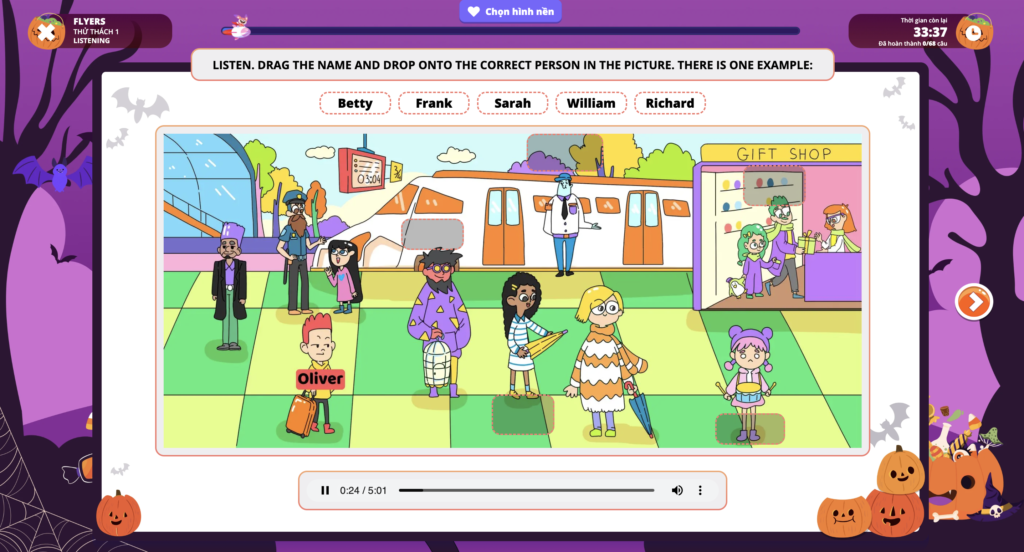
Strategies for the Flyers Listening Test:
| Test Section | Test strategies and study tips for children |
|---|---|
| Part 1 | – Take advantage of the time before the audio starts playing by examining the picture provided. The picture will feature characters engaged in similar actions (standing and talking, carrying backpacks, wearing uniforms, etc.). Therefore, pay attention to the descriptive words that differentiate the characters (color, hairstyle, clothing, etc.). – Familiarize yourself with proper nouns in the Cambridge A2 Flyers vocabulary list. – Review vocabulary related to the topic: clothing, appearance, actions. |
| Part 2 | – Practice listening and quickly take notes of important information. – Understand the meanings and spell the vocabulary words in the Pre A1 Starters, A1 Movers, A2 Flyers word lists. |
| Part 3 | – Read the questions at the beginning of the test to understand the context and instructions. – Pay close attention to the conversation. Two pictures will be mentioned during the dialogue, but they may not be the correct answers. Therefore, don’t rush to select the first answer mentioned, but fully understand the content to choose the correct answer. |
| Part 4 | – Thoroughly practice the structures and vocabulary of the A2 Flyers level. – Listen to the entire dialogue before selecting your answer. The correct answer to each question may be mentioned at any point in the conversation, not necessarily at the beginning or end. |
| Part 5 | – Pay attention to listening to color the mentioned details accurately and find the right place to write the word. – The picture may include similar or closely resembling objects or characters. Therefore, listen carefully to the descriptions before using the coloring pencil. |
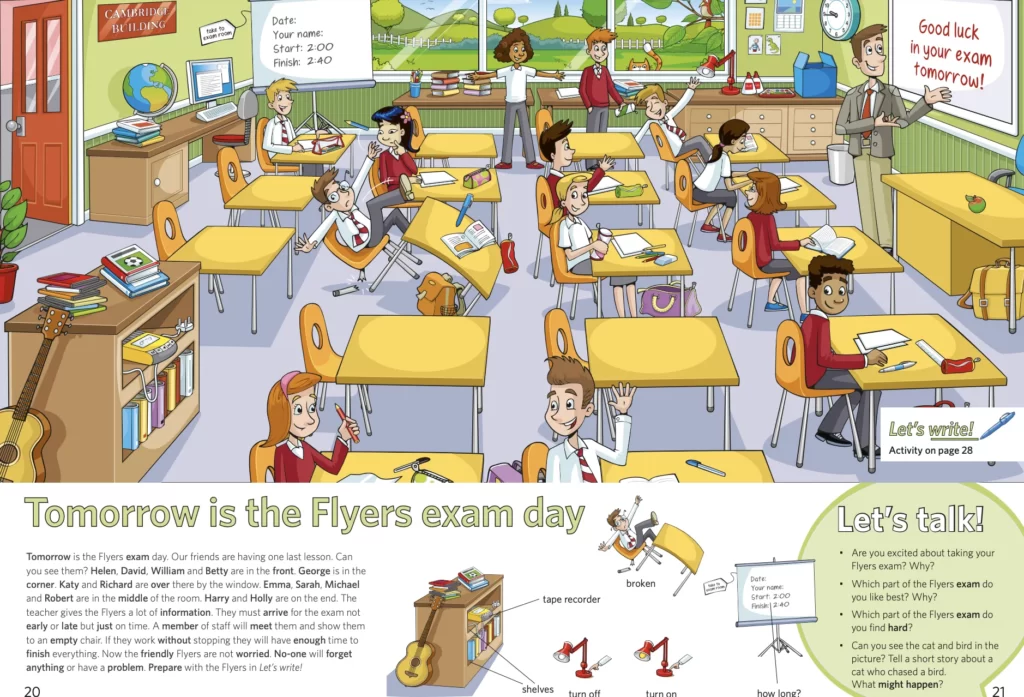
1.2. Reading & Writing test
| Duration | 44 minutes |
| Number of sections | 7 sections/ 44 questions |
| Maximum Score | 5 shields |
Detailed Structure of the Flyers Reading & Writing Test:
| Test Section | Instructions | Necessary skills |
|---|---|---|
| Part 1 | This part consists of 15 words and 10 definitions. The candidate selects the appropriate word to fill in the blank corresponding to that word’s definition. | Matching words with their definitions. |
| Part 2 | Read a dialogue where one person asks a question and another person provides an answer. The answers are listed as options (A to H). You must select the answer by writing its corresponding letter in the blank. | Functional language in various situations. |
| Part 3 | Read a text with 5 blanks and a box containing the words provided. The candidate fills in the appropriate words in the blanks. | Reading specific information and selecting the main idea. |
| Part 4 | Read a text with 10 blanks, choose the correct word from three options provided, and fill in the blanks. | Reading comprehension skills with a given passage, vocabulary, and grammar. |
| Part 5 | Read a story and complete the sentence based on the story’s content, using 1-4 words to fill in the blanks. | Reading and understanding a story, finding different words and phrases with similar meanings. |
| Part 6 | Read a text with 5 blanks. The candidate fills in one missing word in each blank. There is no word list to choose from. | Reading and understanding a short passage, including structure, vocabulary (including phrases and fixed sentences). |
| Part 7 | The candidate writes a short story based on three pictures. | Writing skills and the ability to convey meaning through writing. |

Strategies for the Flyers Reading & Writing Test:
| Test Section | Test strategies and study tips for children |
|---|---|
| Part 1 | – Practice A2 Flyers vocabulary thoroughly by topic, and learn to differentiate between similar or commonly confused words. – Read all the answers and definitions before answering the questions. – Pay attention to spelling of words during the test to avoid spelling errors. |
| Part 2 | – Read all the answers before choosing an answer, as there may be distracting options. – Practice engaging in question-and-answer conversations regularly to anticipate answers when encountering questions. – The correct answer should include words that respond appropriately to the person’s question. |
| Part 3 | – Read the entire text to get an overview of the content beforehand. While reading, you can guess which type of word can be filled in the blank. – Practice selecting the appropriate word form (singular/plural nouns, adjectives, verbs) in a sentence and text. – Review A2 Flyers-level grammar to make accurate judgments about the correct answers. Example: If it’s “some” + blank, the word to fill in must not be a countable singular noun. |
| Part 4 | – Practice selecting the right type of word (noun, adjective, verb, etc.) that fits the sentence or text. – Thoroughly review the regular and irregular forms of verbs in the A2 Flyers vocabulary list. |
| Part 5 | – Read the title and look at the pictures in advance to visualize the context of the story. – Practice distinguishing different ways of referring to people or objects. Example: John, he, him, Paul’s brother. – Practice converting sentences while retaining their meaning. Example: “Last Sunday, our family went to the park to have a picnic” => ”Our family had a picnic in the park last Sunday”. |
| Part 6 | – Review common collocations such as “ask a question,” “do some homework,” etc. – Read the entire text to understand the content better before finding the words to fill in the blanks. |
| Part 7 | – Write more than 20 words but avoid writing excessively long sentences. – Spend time looking at the pictures first to understand the story. Then, write one or two sentences about each picture and consider how they connect events. – You can use the past tense or the present continuous tense. Example: An astronaut arrived on a strange planet. He talked to an alien. Example: An astronaut is arriving on a strange planet. He is talking to an alien. – Review the entire composition after finishing writing. |
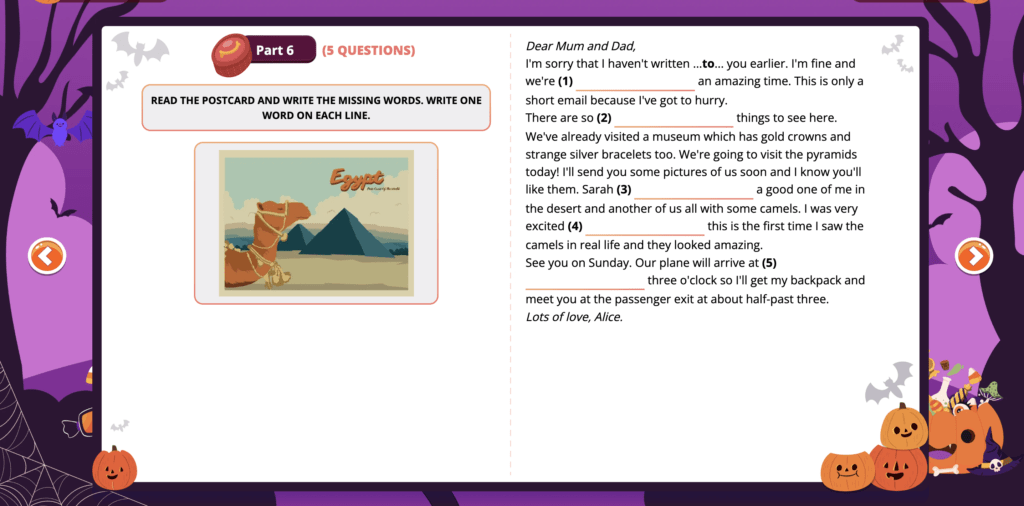
1.3. Speaking test
| Duration | 7-9 minute |
| Number of sections | 4 sections |
| Maximum Score | 5 shields |
Detailed Structure of the Flyers Speaking Test:
| Test Section | Instructions | Necessary skills |
|---|---|---|
| Part 1 | – The examiner greets the candidate and asks for their name, last name, and age. – The candidate views two similar pictures with some differences. The examiner holds one picture to describe it. The candidate identifies 6 differences compared to the description provided by the examiner. | Understanding instructions and describing differences. |
| Part 2 | The examiner asks questions about a person/place/object. The candidate answers, using an information card. Then, the candidate asks the examiner questions based on a different information card. | Answering and asking questions. |
| Part 3 | The examiner shows the candidate a sequence of 5 pictures about a story, providing the story’s name, the character’s name, and a description of the first picture. The candidate describes the remaining 4 pictures. | Describing objects and events. |
| Part 4 | The examiner asks the candidate a few personal questions related to topics such as school, holidays, birthdays, family, and hobbies. | Answering questions about personal information. |
Strategies for the Flyers Speaking Test
| Test Section | Test strategies and study tips for children |
|---|---|
| Part 1 | – Practice listening to descriptions of pictures (e.g., “In my picture, there is a cake”) and relating them to an actual picture while looking for differences (e.g., “In your picture, there are magazines”). – Review vocabulary and grammar structures related to topics such as quantities, colors, locations, appearance, activities, shapes, and sizes, as these will be frequently used in this part. Example: In my picture the clock is square but in your picture the clock is round. |
| Part 2 | – Practice asking and answering questions about personal information, objects, situations, time, place, age, appearance, etc. – Learn how to form questions using question words like “Who, What, When, Where, How old, How many,” etc. Example: What is the name of Robert’s favorite restaurant? – Practice responding to “Yes/No” questions and multiple-choice questions (Example: “Is the restaurant cheap or expensive?”) |
| Part 3 | – For each picture, provide brief descriptions without the need for extensive storytelling. – Review basic structures, including “there is/are,” present tense of “be” and “have (got),” “can/can’t,” “must/mustn’t,” and present continuous tense of some action verbs (e.g., come, go, buy, put on, carry, open, laugh), present perfect, or going to. – Practice expressing simple emotions. Example: The teacher is happy. |
| Part 4 | – Practice answering questions about yourself, your family, friends, home, school, leisure activities, likes and dislikes, and other topics related to your daily life. – You can respond with simple one-word answers, short phrases, or 1-2 short sentences. – Questions will be in the present tense, but you should also know how to use past tense, present perfect, and going to when needed. |
2. A2 Cambridge Flyers scoring scale
The A2 Flyers Cambridge test is scored using “shields” (Cambridge’s symbol). The maximum score for each skill in the test (Listening, Reading & Writing, Speaking) is 5 shields. Therefore, the total number of shields a candidate can achieve in the entire Flyers test is 15 shields.
| 1 shield indicates that the candidate needs to make more effort to improve |
| 5 shields indicate that the candidate has answered most of the questions correctly |
| Achieving 4-5 shields in each skill means that the candidate is ready to prepare for a higher-level exam, such as A2 Key for Schools. |

All candidates who participate will receive the A2 Flyers Cambridge English certificate and a result report that includes their shield score on the test, strengths, and areas that need improvement.
3. Cambridge Flyers online practice
3.1. 200+ Cambridge Flyers practice tests on the Virtual English Testing Platform
The FLYER Virtual English Testing Platform offers 200+ A2 Flyers Cambridge exam practice tests (covering all parts: Listening, Reading & Writing, and Speaking) to provide your child with preparation for the Cambridge Starters exam.
- These exams have been carefully compiled to match the format (up to 90%) following Cambridge’s latest standards.
- The automatic scoring system and answer key will help students review and study effectively at home.
- Interactive exercises and game simulations stimulate children’s brain activity and interest in learning.
- It offers various fun learning features such as challenges with friends, short practice exercises, and vocabulary reviews.
Moreover, a helpful feature for parents is the Learning Report, which makes it easy to track the progress of their children’s studies. The system automatically stores all test results and uses them to provide feedback on the student’s current proficiency level, strengths, and areas that require improvement.
More significantly, parents who use FLYER’s virtual testing platform can save up to 80% on their kids’ exam preparation expenses!
3.2. Cambridge Flyers preparation books
Cambridge provides a list of recommended preparation books, for children who are preparing for the Flyers exam:
- Fun for Flyers
- Story Fun 5
- Story Fun 6
- A2 Flyers 3 | Authentic Examination Papers

Conclusion
This is an overview of the Cambridge A2 Flyers exam structure, which parents can use as a resource to support their children’s preparation. We hope that this information proves beneficial, to parents as they accompany their children on their learning journey.
You may also like


